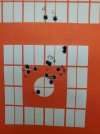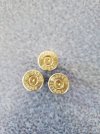Eric Musgrove
Well-Known Member
- Joined
- Sep 25, 2017
- Messages
- 219
2 days prior I did a test with my 6.5 PRC( Browning X-bolt Pro 24" barrel) using H1000, Hornady brass (all that I could get) 143gr E-LDX and Win LR primers, seated to 2.950(mag length) I started at 57 grs and had loaded up to 60gr in .2 gr increments
I hit a fantastic node at 58.6 - 3129 fps, 58.8- 3086 fps, 59.0 3129 fps. 59.2 3137 These three shots were also a bug hole in the target see shots 10,11,12. The barrel was clean prior to the test and I fouled it with 3 rnds of the Hornady factory 143eldx, which also registered over 3000 fps that day, which was about 200fps faster than when the barrel was new that made me go hmm? It also shot a decent group which before it did not seem to like. I shot all of the loads taking along time for the thin fluted barrel to cool between shots.
At 59.4 grs the velocity started to drop off down to 2969 and then around 3000 until the last shot of 60 grs which was 3197, I think this was barrel heat. I had no pressure signs up through the 60 grs. Temp around 80-85 by the time I got to the end. I went home poured over the data, decided to load up 59 grs and go back shoot a group at 100 and 200 yards. I also cleaned the bore again.
2 days latter I returned and fouled the bore with 2 shots of 57.0 and then started my 3 shot group at 100 with 59 gr. The speeds were 2982,2969,2969 temps about the same as before, had pressure signs with ejector marks on all 3 cases and the group was horrible. I put the gun in the truck and came home. I am still not sure what to do, or what is going on. Barrel wasn't fouled enough? What caused the pressure when I had none before with a full grain higher? Crony is garbage? I was so excited about this load and not sure what to do next. Wanted to use it for an up coming ID Bull elk hunt.
Sorry for the long post, tried to eliminate some questions we all usually ask.
I hit a fantastic node at 58.6 - 3129 fps, 58.8- 3086 fps, 59.0 3129 fps. 59.2 3137 These three shots were also a bug hole in the target see shots 10,11,12. The barrel was clean prior to the test and I fouled it with 3 rnds of the Hornady factory 143eldx, which also registered over 3000 fps that day, which was about 200fps faster than when the barrel was new that made me go hmm? It also shot a decent group which before it did not seem to like. I shot all of the loads taking along time for the thin fluted barrel to cool between shots.
At 59.4 grs the velocity started to drop off down to 2969 and then around 3000 until the last shot of 60 grs which was 3197, I think this was barrel heat. I had no pressure signs up through the 60 grs. Temp around 80-85 by the time I got to the end. I went home poured over the data, decided to load up 59 grs and go back shoot a group at 100 and 200 yards. I also cleaned the bore again.
2 days latter I returned and fouled the bore with 2 shots of 57.0 and then started my 3 shot group at 100 with 59 gr. The speeds were 2982,2969,2969 temps about the same as before, had pressure signs with ejector marks on all 3 cases and the group was horrible. I put the gun in the truck and came home. I am still not sure what to do, or what is going on. Barrel wasn't fouled enough? What caused the pressure when I had none before with a full grain higher? Crony is garbage? I was so excited about this load and not sure what to do next. Wanted to use it for an up coming ID Bull elk hunt.
Sorry for the long post, tried to eliminate some questions we all usually ask.
Attachments
Last edited:



